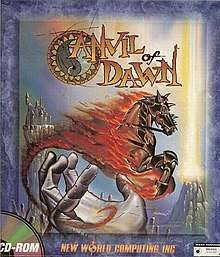Anvil of Dawn
| Anvil of Dawn | |
|---|---|
 | |
| Developer(s) | DreamForge Intertainment |
| Publisher(s) | New World Computing |
| Platform(s) | MS-DOS, Windows |
| Release | October 31, 1995 |
| Genre(s) | Computer role-playing game |
| Mode(s) | Single player |
Anvil of Dawn is a 1995 fantasy role-playing video game developed by DreamForge Intertainment and published by New World Computing.[1] In 1996, Computer Gaming World named it as their roleplaying game of the year.[2] In 2013, the game was re-released via GOG.com with Windows support.
Game
The game was released 1995 for MS-DOS and was one of the last of the classical DOS RPGs with blockstep movements and semi-3D environment. The game presents a real-time, three-dimensional view from the character's perspective. It was released on CD and features fully spoken dialogue and several pre-rendered cutscenes. The player controls only one character throughout the game, which is chosen at the beginning from 5 different heroes.[3] The other characters can then be met in the game also trying to fulfill the quest. The game is mostly action oriented but also contains some puzzles. There are no experience points as the character gets better through using his abilities and spells. It also features several different endings.
Plot
The game plays in the world of Tempest. The civilization had been overrun by an evil warlord and the last castle of the good is under siege. The player's character is then teleported in the already occupied and devastated land, where he strives to fulfill his quest to defeat the warlord and his minions.
Development
Anvil of Dawn was developed by DreamForge Intertainment. In the concept stage, the team chose to focus the game on atmosphere and player immersion, which led to the decision to pre-render the game's environments via three-dimensional (3D) graphical models. While real-time 3D graphics were used by certain other dungeon crawl games at the time, DreamForge believed that their environments looked "flat and pixellated", and sought greater realism through pre-rendering. For the outdoor scenes, the team lined 3D models of each environment with "movement nodes", and pre-recorded "mini-cinematics" to animate transitions from one node to another. Their objective was to make the game feel seamless, whether the player was stepping through an area or moving between dungeons.[4]
The goal of uninterrupted immersion led them to simplify the game's interface, to reduce the number of heads-up display icons and to include automatically-updated quest logs, spellbooks and maps. According to the company's Chris Straka, the team "made every effort to bridge the gap between the novice and the expert player", without automating too much of the gameplay. So that players could immediately understand and play Anvil of Dawn, DreamForge chose to make the game completable with only the left mouse button. This decision in turn inspired the team to limit the game to a single player character, instead of a party-based system. Straka explained, "In this way, we didn't have to worry about multiple characters, multiple faces, multiple inventories, etc., and how all the possible combinations can be made functional with a simple left click."[4]
Several months were dedicated to the conception and implementation of magic, and a pseudo-turn-based system was devised to handle fighting. Enemies attack at set intervals, which DreamForge tried to make long enough that players did not "feel overly rushed" during combat. However, enemies are also programmed to counterattack each of the player's strikes, after which they return to the waiting interval. This allows the player to set the pace of combat: attacking rapidly increases enemies' attack speed in turn, while attacking slowly decreases it.[4]
Reception
| Reception | ||||||||||
|---|---|---|---|---|---|---|---|---|---|---|
| ||||||||||
Writing for PC Gamer US, Trent C. Ward called Anvil of Dawn an "attractive and enjoyable RPG that doesn't stretch the boundaries very far."[5] In Computer Gaming World, Scorpia summarized the game as "a dungeon romp with several points of interest, and a couple of pleasant surprises."[3] Computer Gaming World later named Anvil of Dawn its "Role-Playing Game of the Year". The editors singled out the game's "playability and balance" as reasons for their decision.[2] It also won "Role Playing Game of the Year" from Computer Game Review, whose editors called it "an excellent job all the way around."[8]
In his book Dungeons and Desktops: The History of Computer Role-Playing Games (2008), the video game historian Matt Barton declared Anvil of Dawn "one of the best of the Dungeon Master-inspired games". He cited the game's "careful pacing, splendid music, and ... superior interface" as high points.[9]
References
- ↑ Anvil of Dawn Manual. New World Computing. 1995. p. 3.
- 1 2 Staff (June 1996). "1996 Premiere Awards". Computer Gaming World. Ziff-Davis Publishing C. 143: 55–67.
- 1 2 Scorpia (February 1996). "Champions of Might and Magic: New World's Anvil of Dawn casts quite a spell". Computer Gaming World. Ziff-Davis Publishing C. 139: 107–111. See also the advert on pp. 8–9.
- 1 2 3 Straka, Chris (December 1995). "Design Notes; Anvil of Dawn". Computer Games Strategy Plus (61): 40, 41.
- 1 2 Ward, Trent C. (March 1996). "Anvil of Dawn". PC Gamer US. Archived from the original on November 12, 1999.
- ↑ Snyder, Frank; Chapman, Ted; Honeywell, Steve (January 1996). "Forging Ahead". Computer Game Review. Archived from the original on December 22, 1996.
- ↑ Klett, Steve (February 1996). "Anvil of Dawn". PC Entertainment. Archived from the original on October 18, 1996.
- ↑ Staff (April 1996). "CGR's Year in Review". Computer Game Review. Archived from the original on October 18, 1996.
- ↑ Barton, Matt (February 22, 2008). Dungeons and Desktops: The History of Computer Role-Playing Games. A K Peters. pp. 247–248. ISBN 1568814119.
External links
- Official site (archived)
- Anvil of Dawn at MobyGames